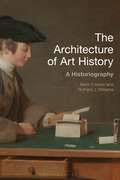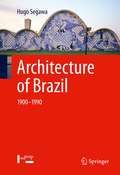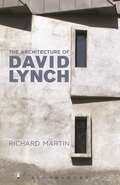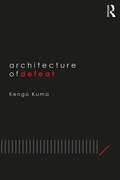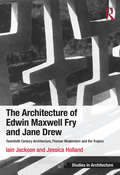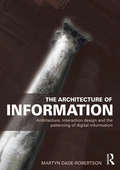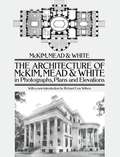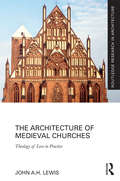- Table View
- List View
The Architecture of Art History: A Historiography (History of Art and Architecture)
by Mark Crinson Richard J. WilliamsWhat is the place of architecture in the history of art? Why has it been at times central to the discipline, and at other times seemingly so marginal? What is its place now? Many disciplines have a stake in the history of architecture – sociology, anthropology, human geography, to name a few. This book deals with perhaps the most influential tradition of all – art history – examining how the relation between the disciplines of art history and architectural history has waxed and waned over the last one hundred and fifty years. In this highly original study, Mark Crinson and Richard J. Williams point to a decline in the importance attributed to the role of architecture in art history over the last century – which has happened without crisis or self-reflection. The book explores the problem in relation to key art historical approaches, from formalism, to feminism, to the social history of art, and in key institutions from the Museum of Modern Art, to the journal October. Among the key thinkers explored are Banham, Baxandall, Giedion, Panofsky, Pevsner, Pollock, Riegl, Rowe, Steinberg, Wittkower and Wölfflin. The book will provoke debate on the historiography and present state of the discipline of art history, and it makes a powerful case for the reconsideration of architecture.
Architecture of Brazil: 1900-1990
by Hugo SegawaArchitecture of Brazil: 1900-1990 examines the processes that underpin modern Brazilian architecture under various influences and characterizes different understandings of modernity, evident in the chapter topics of this book. Accordingly, the author does not give overall preference to particular architects nor works, with the exception of a few specific works and architects, including Warchavchik, Niemeyer, Lucio Costa, and Vilanova Artigas.
The Architecture of David Lynch
by Richard MartinFrom the Red Room in Twin Peaks to Club Silencio in Mulholland Drive, the work of David Lynch contains some of the most remarkable spaces in contemporary culture. Richard Martin's compelling study is the first sustained critical assessment of the role architecture and design play in Lynch's films. Martin combines original research at Lynchian locations in Los Angeles, London and Lódz with insights from architects including Adolf Loos, Le Corbusier and Jean Nouvel and urban theorists such as Jane Jacobs and Edward Soja. In analyzing the towns, cities, homes, roads and stages found in Lynch's work, Martin not only reveals their central importance for understanding this controversial and distinctive film-maker,but also suggests how Lynch's films can provide a deeper understanding of the places and spaces in which we live.
The Architecture of David Lynch
by Richard MartinFrom the Red Room in Twin Peaks to Club Silencio in Mulholland Drive, the work of David Lynch contains some of the most remarkable spaces in contemporary culture. Richard Martin's compelling study is the first sustained critical assessment of the role architecture and design play in Lynch's films. Martin combines original research at Lynchian locations in Los Angeles, London and Lódz with insights from architects including Adolf Loos, Le Corbusier and Jean Nouvel and urban theorists such as Jane Jacobs and Edward Soja. In analyzing the towns, cities, homes, roads and stages found in Lynch's work, Martin not only reveals their central importance for understanding this controversial and distinctive film-maker,but also suggests how Lynch's films can provide a deeper understanding of the places and spaces in which we live.
Architecture of Defeat
by Kengo KumaKengo Kuma, one of Japan’s leading architects, has been combining professional practice and academia for most of his career. In addition to creating many internationally recognized buildings all over the world, he has written extensively about the history and theory of architecture. Like his built work, his writings also reflect his profound personal philosophy. Architecture of Defeat is no exception. Now available in English for the first time, the book explores events and architectural trends in the twentieth and twenty-first centuries in both Japan and beyond. It brings together a collection of essays which Kuma wrote after disasters such as the destruction of the World Trade Center in New York City on 9/11 and the earthquake and tsunami that obliterated much of the built landscape on Japan’s northern shore in a matter of minutes in 2011. Asking if we have been building in a manner that is too self-confident or arrogant, he examines architecture’s intrinsic—and often problematic—relationship to the powerful forces of contemporary politics, economics, consumerism, and technology, as well as its vital ties to society. Despite the title, Architecture of Defeat is an optimistic and hopeful book. Rather than anticipating the demise of architecture, Kuma envisages a different mode of conceiving architecture: guided and shaped by more modesty and with greater respect for the forces of our natural world. Beautifully designed and illustrated, this is a fascinating insight into the thinking of one of the world’s most influential architects.
Architecture of Defeat
by Kengo KumaKengo Kuma, one of Japan’s leading architects, has been combining professional practice and academia for most of his career. In addition to creating many internationally recognized buildings all over the world, he has written extensively about the history and theory of architecture. Like his built work, his writings also reflect his profound personal philosophy. Architecture of Defeat is no exception. Now available in English for the first time, the book explores events and architectural trends in the twentieth and twenty-first centuries in both Japan and beyond. It brings together a collection of essays which Kuma wrote after disasters such as the destruction of the World Trade Center in New York City on 9/11 and the earthquake and tsunami that obliterated much of the built landscape on Japan’s northern shore in a matter of minutes in 2011. Asking if we have been building in a manner that is too self-confident or arrogant, he examines architecture’s intrinsic—and often problematic—relationship to the powerful forces of contemporary politics, economics, consumerism, and technology, as well as its vital ties to society. Despite the title, Architecture of Defeat is an optimistic and hopeful book. Rather than anticipating the demise of architecture, Kuma envisages a different mode of conceiving architecture: guided and shaped by more modesty and with greater respect for the forces of our natural world. Beautifully designed and illustrated, this is a fascinating insight into the thinking of one of the world’s most influential architects.
The Architecture of Edwin Maxwell Fry and Jane Drew: Twentieth Century Architecture, Pioneer Modernism and the Tropics (Ashgate Studies in Architecture)
by Iain Jackson Jessica HollandMaxwell Fry and Jane Drew were pioneers of Modern Architecture in Britain and its former colonies from the late 1920s through to the early 1970s. As a barometer of twentieth century architecture, their work traces the major cultural developments of that century from the development of modernism, its spread into the late-colonial arena and finally, to its re-evaluation that resulted in a more expressive, formalist approach in the post-war era. This book thoroughly examines Fry and Drew's highly influential 'Tropical Architecture' in West Africa and India, whilst also discussing their British work, such as their post World War II projects for the Festival of Britain, Harlow New Town, Pilkington Brothers’ Headquarters and Coychurch Crematorium. It highlights the collaborative nature of Fry and Drew's work, including schemes undertaken with Elizabeth Denby, Walter Gropius, Denys Lasdun, Pierre Jeanneret and Le Corbusier. Positioning their architecture, writing and educational endeavours within a wider context, this book illustrates the significant artistic and cultural contributions made by Fry and Drew throughout their lengthy careers.
The Architecture of Edwin Maxwell Fry and Jane Drew: Twentieth Century Architecture, Pioneer Modernism and the Tropics (Ashgate Studies in Architecture)
by Iain Jackson Jessica HollandMaxwell Fry and Jane Drew were pioneers of Modern Architecture in Britain and its former colonies from the late 1920s through to the early 1970s. As a barometer of twentieth century architecture, their work traces the major cultural developments of that century from the development of modernism, its spread into the late-colonial arena and finally, to its re-evaluation that resulted in a more expressive, formalist approach in the post-war era. This book thoroughly examines Fry and Drew's highly influential 'Tropical Architecture' in West Africa and India, whilst also discussing their British work, such as their post World War II projects for the Festival of Britain, Harlow New Town, Pilkington Brothers’ Headquarters and Coychurch Crematorium. It highlights the collaborative nature of Fry and Drew's work, including schemes undertaken with Elizabeth Denby, Walter Gropius, Denys Lasdun, Pierre Jeanneret and Le Corbusier. Positioning their architecture, writing and educational endeavours within a wider context, this book illustrates the significant artistic and cultural contributions made by Fry and Drew throughout their lengthy careers.
Architecture of First Societies: A Global Perspective
by Mark M. Jarzombek“This book is the most comprehensively global and critically sensitive synthesis of what we now know of the material and socio-cultural evolution of the so-called First Societies. Written by a distinguished architectural historian and theorist, this truly remarkable and indispensable study shows how the material culture of our forebears, from building to clothing, food, ritual and dance, was inextricably bound up with the mode of survival obtained in a particular place and time…It is a study that will surely become required reading for every student of material culture.”—Kenneth Frampton Starting with the dawn of human society, through early civilizations, to the pre-Columbian American tribes, Architecture of First Societies: A Global Perspective traces the different cultural formations that developed in various places throughout the world to form the built environment. Looking through the lens of both time and geography, the history of early architecture is brought to life with full-color photographs, maps, and drawings. Drawing on the latest research in archaeological and anthropological knowledge, this landmark book also looks at how indigenous societies build today in order to help inform the past.
Architecture of First Societies: A Global Perspective
by Mark M. Jarzombek“This book is the most comprehensively global and critically sensitive synthesis of what we now know of the material and socio-cultural evolution of the so-called First Societies. Written by a distinguished architectural historian and theorist, this truly remarkable and indispensable study shows how the material culture of our forebears, from building to clothing, food, ritual and dance, was inextricably bound up with the mode of survival obtained in a particular place and time…It is a study that will surely become required reading for every student of material culture.”—Kenneth Frampton Starting with the dawn of human society, through early civilizations, to the pre-Columbian American tribes, Architecture of First Societies: A Global Perspective traces the different cultural formations that developed in various places throughout the world to form the built environment. Looking through the lens of both time and geography, the history of early architecture is brought to life with full-color photographs, maps, and drawings. Drawing on the latest research in archaeological and anthropological knowledge, this landmark book also looks at how indigenous societies build today in order to help inform the past.
The Architecture of Frank Lloyd Wright, Fourth Edition: A Complete Catalog
by William Allin StorrerFrom sprawling houses to compact bungalows and from world-famous museums to a still-working gas station, Frank Lloyd Wright’s designs can be found in nearly every corner of the country. While the renowned architect passed away more than fifty years ago, researchers and enthusiasts are still uncovering structures that should be attributed to him. William Allin Storrer is one of the experts leading this charge, and his definitive guide, The Architecture of Frank Lloyd Wright, has long been the resource of choice for anyone interested in Wright. Thanks to the work of Storrer and his colleagues at the Rediscovering Wright Project, thirty-seven new sites have recently been identified as the work of Wright. Together with more photos, updated and expanded entries, and a new essay on the evolution of Wright’s unparalleled architectural style, this new edition is the most comprehensive and authoritative catalog available. Organized chronologically, the catalog includes full-color photos, location information, and historical and architectural background for all of Wright’s extant structures in the United States and abroad, as well as entries for works that have been demolished over the years. A geographic listing makes it easy for traveling Wright fans to find nearby structures and a new key indicates whether a site is open to the public. Publishing for Wright’s sesquicentennial, this new edition will be a trusted companion for anyone embarking on their own journeys through the wonder and genius of Frank Lloyd Wright.
The Architecture of Frank Lloyd Wright, Fourth Edition: A Complete Catalog
by William Allin StorrerFrom sprawling houses to compact bungalows and from world-famous museums to a still-working gas station, Frank Lloyd Wright’s designs can be found in nearly every corner of the country. While the renowned architect passed away more than fifty years ago, researchers and enthusiasts are still uncovering structures that should be attributed to him. William Allin Storrer is one of the experts leading this charge, and his definitive guide, The Architecture of Frank Lloyd Wright, has long been the resource of choice for anyone interested in Wright. Thanks to the work of Storrer and his colleagues at the Rediscovering Wright Project, thirty-seven new sites have recently been identified as the work of Wright. Together with more photos, updated and expanded entries, and a new essay on the evolution of Wright’s unparalleled architectural style, this new edition is the most comprehensive and authoritative catalog available. Organized chronologically, the catalog includes full-color photos, location information, and historical and architectural background for all of Wright’s extant structures in the United States and abroad, as well as entries for works that have been demolished over the years. A geographic listing makes it easy for traveling Wright fans to find nearby structures and a new key indicates whether a site is open to the public. Publishing for Wright’s sesquicentennial, this new edition will be a trusted companion for anyone embarking on their own journeys through the wonder and genius of Frank Lloyd Wright.
The Architecture of Frank Lloyd Wright, Fourth Edition: A Complete Catalog
by William Allin StorrerFrom sprawling houses to compact bungalows and from world-famous museums to a still-working gas station, Frank Lloyd Wright’s designs can be found in nearly every corner of the country. While the renowned architect passed away more than fifty years ago, researchers and enthusiasts are still uncovering structures that should be attributed to him. William Allin Storrer is one of the experts leading this charge, and his definitive guide, The Architecture of Frank Lloyd Wright, has long been the resource of choice for anyone interested in Wright. Thanks to the work of Storrer and his colleagues at the Rediscovering Wright Project, thirty-seven new sites have recently been identified as the work of Wright. Together with more photos, updated and expanded entries, and a new essay on the evolution of Wright’s unparalleled architectural style, this new edition is the most comprehensive and authoritative catalog available. Organized chronologically, the catalog includes full-color photos, location information, and historical and architectural background for all of Wright’s extant structures in the United States and abroad, as well as entries for works that have been demolished over the years. A geographic listing makes it easy for traveling Wright fans to find nearby structures and a new key indicates whether a site is open to the public. Publishing for Wright’s sesquicentennial, this new edition will be a trusted companion for anyone embarking on their own journeys through the wonder and genius of Frank Lloyd Wright.
The Architecture of Frank Lloyd Wright, Fourth Edition: A Complete Catalog
by William Allin StorrerFrom sprawling houses to compact bungalows and from world-famous museums to a still-working gas station, Frank Lloyd Wright’s designs can be found in nearly every corner of the country. While the renowned architect passed away more than fifty years ago, researchers and enthusiasts are still uncovering structures that should be attributed to him. William Allin Storrer is one of the experts leading this charge, and his definitive guide, The Architecture of Frank Lloyd Wright, has long been the resource of choice for anyone interested in Wright. Thanks to the work of Storrer and his colleagues at the Rediscovering Wright Project, thirty-seven new sites have recently been identified as the work of Wright. Together with more photos, updated and expanded entries, and a new essay on the evolution of Wright’s unparalleled architectural style, this new edition is the most comprehensive and authoritative catalog available. Organized chronologically, the catalog includes full-color photos, location information, and historical and architectural background for all of Wright’s extant structures in the United States and abroad, as well as entries for works that have been demolished over the years. A geographic listing makes it easy for traveling Wright fans to find nearby structures and a new key indicates whether a site is open to the public. Publishing for Wright’s sesquicentennial, this new edition will be a trusted companion for anyone embarking on their own journeys through the wonder and genius of Frank Lloyd Wright.
The Architecture of Industry: Changing Paradigms in Industrial Building and Planning (Ashgate Studies in Architecture)
by Mathew AitchisonFrom the Rust Belt to Silicon Valley, the intersection between architecture and industry has provided a rich and evolving source for historians of architecture. In a historical context, industrial architecture evokes the smoking factories of the nineteenth century or Fordist production complexes of the twentieth century. This book documents the changing nature of industrial building and planning from the end of the nineteenth century to the beginning of the twenty-first century. Drawing on research from the United States, Europe and Australia, this collection of essays highlights key moments in industrial architecture and planning representative of the wider paradigms in the field. Areas of analysis include industrial production, factories, hydroelectricity, aerospace, logistics, finance, scientific research and mining. The selected case studies serve to highlight architectural and planning innovations in industry and their contributions to wider cultural and societal currents. This richly illustrated collection will be of interest for a wide range of built environment studies, incorporating findings from both historical and theoretical scholarship and design research.
The Architecture of Industry: Changing Paradigms in Industrial Building and Planning (Ashgate Studies in Architecture)
by Mathew AitchisonFrom the Rust Belt to Silicon Valley, the intersection between architecture and industry has provided a rich and evolving source for historians of architecture. In a historical context, industrial architecture evokes the smoking factories of the nineteenth century or Fordist production complexes of the twentieth century. This book documents the changing nature of industrial building and planning from the end of the nineteenth century to the beginning of the twenty-first century. Drawing on research from the United States, Europe and Australia, this collection of essays highlights key moments in industrial architecture and planning representative of the wider paradigms in the field. Areas of analysis include industrial production, factories, hydroelectricity, aerospace, logistics, finance, scientific research and mining. The selected case studies serve to highlight architectural and planning innovations in industry and their contributions to wider cultural and societal currents. This richly illustrated collection will be of interest for a wide range of built environment studies, incorporating findings from both historical and theoretical scholarship and design research.
The Architecture of Information: Architecture, Interaction Design and the Patterning of Digital Information
by Martyn Dade-RobertsonThis book looks at relationships between the organization of physical objects in space and the organization of ideas. Historical, philosophical, psychological and architectural knowledge are united to develop an understanding of the relationship between information and its representation. Despite its potential to break the mould, digital information has relied on metaphors from a pre-digital era. In particular, architectural ideas have pervaded discussions of digital information, from the urbanization of cyberspace in science fiction, through to the adoption of spatial visualizations in the design of graphical user interfaces. This book tackles: the historical importance of physical places to the organization and expression of knowledge the limitations of using the physical organization of objects as the basis for systems of categorization and taxonomy the emergence of digital technologies and the twentieth century new conceptual understandings of knowledge and its organization the concept of disconnecting storage of information objects from their presentation and retrieval ideas surrounding ‘semantic space’ the realities of the types of user interface which now dominate modern computing.
The Architecture of Information: Architecture, Interaction Design and the Patterning of Digital Information
by Martyn Dade-RobertsonThis book looks at relationships between the organization of physical objects in space and the organization of ideas. Historical, philosophical, psychological and architectural knowledge are united to develop an understanding of the relationship between information and its representation. Despite its potential to break the mould, digital information has relied on metaphors from a pre-digital era. In particular, architectural ideas have pervaded discussions of digital information, from the urbanization of cyberspace in science fiction, through to the adoption of spatial visualizations in the design of graphical user interfaces. This book tackles: the historical importance of physical places to the organization and expression of knowledge the limitations of using the physical organization of objects as the basis for systems of categorization and taxonomy the emergence of digital technologies and the twentieth century new conceptual understandings of knowledge and its organization the concept of disconnecting storage of information objects from their presentation and retrieval ideas surrounding ‘semantic space’ the realities of the types of user interface which now dominate modern computing.
The Architecture of Late Assyrian Royal Palaces
by David KertaiThe Late Assyrian Empire (c. 900 - 612 BCE) was the first state to rule over the major centres of the Middle East, and the Late Assyrian court inhabited some of the most monumental palaces of its time. The Architecture of Late Assyrian Royal Palaces is the first volume to provide an in-depth analysis of Late Assyrian palatial architecture, offering a general introduction to all key royal palaces in the major centres of the empire: Assur, Kalḫu, Dur-Sharruken, and Nineveh. Where previous research has often focused on the duality between public and private realms, this volume redefines the cultural principles governing these palaces and proposes a new historical framework, analysing the spatial organization of the palace community which placed the king front and centre. It brings together the architecture of such palaces as currently understood within the broader framework of textual and art-historical sources, and argues that architectural changes were guided by a need to accommodate ever larger groups as the empire grew in size.
The Architecture of Matter
by June Goodfield Stephen Toulmin"Warmly recommended. It is that rare achievement, a lively book which at the same time takes the fullest possible advantage of scholarly knowledge."—Charles C. Gillespie, New York Times Book Review
The Architecture of McKim, Mead & White in Photographs, Plans and Elevations
by Mead White McKimThe roster of McKim, Mead & White's clients reads like a who's-who of American business, professional, cultural, and social enterprise in the late nineteenth and early twentieth centuries. Many of the buildings designed by this distinguished New York firm still stand today — libraries, museums, churches, train stations, banks, office buildings, private clubs, and residences — an imposing testament to the splendor and durability of its achievement.This magnificent pictorial history is one of the most important documents in the history of American architecture. In 435 superb photographs and over 500 line illustrations, including both floor plans and elevations, it surveys over 160 structures designed by the architects of McKim, Mead & White. Originally published in four massive volumes and now available in an unabridged one-volume paperback edition, this handsome book depicts such famous New York City landmarks (present and former) as Columbia University's Low Library, the Pierpont Morgan Library, the Municipal Building, the second Madison Square Garden, and the original Pennsylvania Station.Other major landmarks include private and public buildings and other structures in Boston, Cambridge, Newport, Providence, Princeton, Philadelphia, Washington, D.C., Chicago, and Montreal. For architects and architectural historians, this book will be a valuable source for its comprehensive views of an unrivaled achievement in American architecture. Social historians and students of Americana will find it revealing for its reflection of the ideas and culture of the times. A new Introduction by Richard Guy Wilson perceptively appraises the McKim, Mead & White legacy for today's readers.
The Architecture of Medieval Churches: Theology of Love in Practice (Routledge Research in Architecture)
by John A.H. LewisThe Architecture of Medieval Churches investigates the impact of affective theology on architecture and artefacts, focusing on the Middle Ages as a period of high achievement of this synthesis. It explores aspects of medieval church and cathedral architecture in relation to the contemporary metaphysics and theology, which articulated an integrated theocentric culture, architecture, and art. Three modes of attention: comprehension, instruction, and contemplation, informed the builders’ intuition and intention. The book’s central premise reasons that love for God was the critical force in the creation of vernacular church architecture, using a selection of medieval writings to provide a unique critique of the genius of architecture and art during this period. An interdisciplinary study between architecture, theology, and philosophy, it will appeal to academics and researchers in these fields.
The Architecture of Medieval Churches: Theology of Love in Practice (Routledge Research in Architecture)
by John A.H. LewisThe Architecture of Medieval Churches investigates the impact of affective theology on architecture and artefacts, focusing on the Middle Ages as a period of high achievement of this synthesis. It explores aspects of medieval church and cathedral architecture in relation to the contemporary metaphysics and theology, which articulated an integrated theocentric culture, architecture, and art. Three modes of attention: comprehension, instruction, and contemplation, informed the builders’ intuition and intention. The book’s central premise reasons that love for God was the critical force in the creation of vernacular church architecture, using a selection of medieval writings to provide a unique critique of the genius of architecture and art during this period. An interdisciplinary study between architecture, theology, and philosophy, it will appeal to academics and researchers in these fields.
The Architecture of Modern Empire
by Arundhati RoyFrom the bestselling author of Azadi and My Seditious Heart, a piercing exploration of modern empire, nationalism and rising fascism that gives us the tools to resist and fight back‘I try to create links, to join the dots, to tell politics like a story, to make it real…’Over a lifetime spent at the frontline of solidarity and resistance, Arundhati Roy’s words have lit a clear way through the darkness that surrounds us. Combining the skills of the architect she trained to be and the writer she became, she illuminates the hidden structures of modern empire like no one else, revealing their workings so that we can resist.Her subjects: war, nationalism, fundamentalism and rising fascism, turbocharged by neoliberalism and now technology. But also: truth, justice, freedom, resistance, solidarity and above all imagination – in particular the imagination to see what is in front of us, to envision another way, and to fight for it.Arundhati Roy’s voice – as distinct and compelling in conversation as in her writing – explores these themes and more in this essential collection of interviews with David Barsamian, conducted over two decades, from 2001 to the present.WITH AN AFTERWORD FROM NAOMI KLEIN
The Architecture of Neoliberalism: How Contemporary Architecture Became an Instrument of Control and Compliance
by Douglas SpencerThe Architecture of Neoliberalism pursues an uncompromising critique of the neoliberal turn in contemporary architecture. This book reveals how a self-styled parametric and post-critical architecture serves mechanisms of control and compliance while promoting itself, at the same time, as progressive. Spencer's incisive analysis of the architecture and writings of figures such as Zaha Hadid, Patrik Schumacher, Rem Koolhaas, and Greg Lynn shows them to be in thrall to the same notions of liberty as are propounded in neoliberal thought. Analysing architectural projects in the fields of education, consumption and labour, The Architecture of Neoliberalism examines the part played by contemporary architecture in refashioning human subjects into the compliant figures - student-entrepreneurs, citizen-consumers and team-workers - requisite to the universal implementation of a form of existence devoted to market imperatives.
